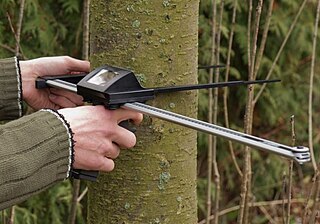Loading AI tools
Standard method of expressing the diameter of the trunk or bole of a standing tree From Wikipedia, the free encyclopedia
Diameter at breast height, or DBH, is a standard method of expressing the diameter of the trunk or bole of a standing tree. DBH is one of the most common dendrometric measurements.


Tree trunks are measured at the height of an adult's breast, which is defined differently in different countries and situations. In many countries, DBH is measured at approximately 1.3 m (4.3 ft) above ground.[1][2]
The height can make a substantial difference to the measured diameter.[3]
In the United States, DBH is typically measured at 4.5 ft (1.37 m) above ground.[4][5] In some countries, such as Australia, New Zealand, Burma, India, Malaysia, and South Africa, breast height diameter has historically been measured at a height of 1.4 m (4 ft 7 in), but because of much active research into allometrics that are being applied to trees and forests, the convention of 1.3 m (4.3 ft) is more appropriate.[citation needed] Ornamental trees are usually measured at 1.5 metres above ground.[citation needed]
Some authors[6] have argued that the term DBH should be abolished because the heights at which the diameter is measured are excessively variable and imprecise, and imprecise measurements could strongly influence forestry calculations such as biomass. Alternatives proposed [by whom?] have included Dx whereby the x denotes the exact height above the floor (and along the stem) at which the diameter is measured.[citation needed] For instance D130 denotes a diameter measured at 130 cm above the floor and along the stem.
On sloping ground, the "above ground" reference point is usually taken as the highest point on the ground touching the trunk, but some use the average between the highest and lowest points of ground. If the DBH point falls on a swelling in the trunk it is customary to measure the girth below the swelling at the point where the diameter is smallest. Other ambiguous settings for determining the exact place where to measure the diameter is given in Dahdouh-Guebas & Koedam (2006).[7]

The two most common instruments used to measure DBH are a girthing (or diameter) tape and calipers.
A girthing tape actually measures the girth (circumference) of the tree; the girthing tape is calibrated in divisions of π centimetres (3.14159 cm). The measure assumes the trunk has a circular cross-section and gives a directly converted reading of the diameter.[citation needed] It is accurate for most plantation trees.[according to whom?]
Calipers consist of two parallel arms one of which is fixed and the other able to slide along a scale. Calipers are held at right-angles to the trunk with the arms on either side of the trunk. Precision can be improved on non-circular stems by averaging two caliper measurements taken at right-angles. Electronic calipers are also available enabling highly accurate measurements to be taken and stored for further analysis.[citation needed]
DBH is used in estimating the amount of timber volume in a single tree or stand of trees utilising the allometric correlation between stem diameter, tree height and timber volume.[8] It can also be used in the estimation of the age of veteran trees, given that diameter increment is the only "constant non-reversible feature of tree growth".[9]
Seamless Wikipedia browsing. On steroids.
Every time you click a link to Wikipedia, Wiktionary or Wikiquote in your browser's search results, it will show the modern Wikiwand interface.
Wikiwand extension is a five stars, simple, with minimum permission required to keep your browsing private, safe and transparent.